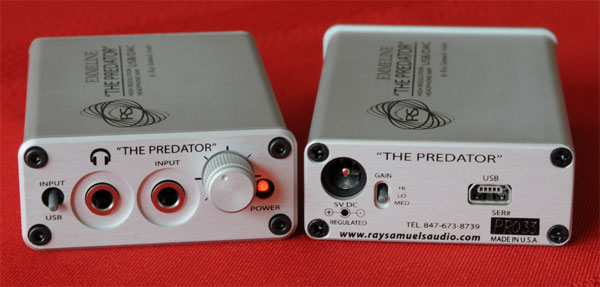March 21, 2008
Enter The Predator
After a recent move from
one coast to the other, we’re renting a small house while we wait for the real-estate
market to settle down. I’ve been listening with headphones almost daily, as our
rental house is small and my listening would disturb my wife and daughter as they sleep. I
have a pair of Sennheiser HD 600s for use with my MacBook, and a pair of Etymotic ER-4Ses
for travel. To power both of these, I’ve used a HeadRoom Total AirHead headphone
amplifier, first with a portable CD player and now with my laptop. The Total AirHead is a
nice, inexpensive little amp that has served its purpose, but because I’ve been
spending so much time listening with headphones, I wanted an amp that would take advantage
of my laptop’s USB output and run the signal through a DAC within the amp. Yes, I
know HeadRoom makes such an amp, the Total BitHead, but although I’ve enjoyed using
the Total AirHead, I’ve never liked its noisy volume control, and there’s no
gain adjustment for headphones with different impedances. The HeadRoom crossfeed circuit
is subtle at best, so that hasn't been an important feature for me. Plus, as we
audiophiles are prone to do, I just wanted to try something different.

Enter the Ray
Samuels Audio Emmeline, The Predator ($475 USD). Smaller than a pack of cigarettes,
this headphone amp still packs quite a bit of functionality into its aluminum chassis. The
front panel has a volume control with a silky-smooth action, an analog input, a mini
headphone output jack, a switch for selecting USB or analog input and a power switch that
glows orange when the unit is on. The back panel has the USB input, a switch for low,
medium and high gain, plus a jack for the supplied AC adapter/charger. Battery power is
supplied by an internal lithium battery that, with daily use of eight hours per day, is
claimed to have a life of almost ten years. The DAC chipset itself is specified to be of
the highest grade, but Samuels is no more forthcoming than that.
How does The Predator sound? In a word, amazing.
With the analog input, I had better-than-respectable sound, certainly better than the
Total AirHead, but via the USB input, the presentation underwent a fundamental
transformation. Background noise was nonexistent, and the volume control seemed completely
transparent. The music had a realistic and holographic character, with detail that was
previously masked via the Total AirHead now revealed in all its glory. What is more
incredible is that the greatest difference was not with 16-bit/44.1kHz recordings but with
the 128kbps stream from the jazz radio station KKJZ via iTunes. The music and in-studio
banter from the DJs seemed so natural and lifelike that it was hard to believe that this
was a compressed stream. With sound this good, I’d be hard-pressed to justify
spending more money on any other headphone amp.
The Predator offers huge bang for the buck. If
you listen through cans at home, at work or while traveling, you’ll find that not
only can you afford this little jewel, you cannot live without it.
...Uday Reddy
uday@soundstage.com
| "SoundStage!
Update" Archives |
|